2008 MERCEDES-BENZ E-CLASS ESTATE remove seats
[x] Cancel search: remove seatsPage 80 of 401
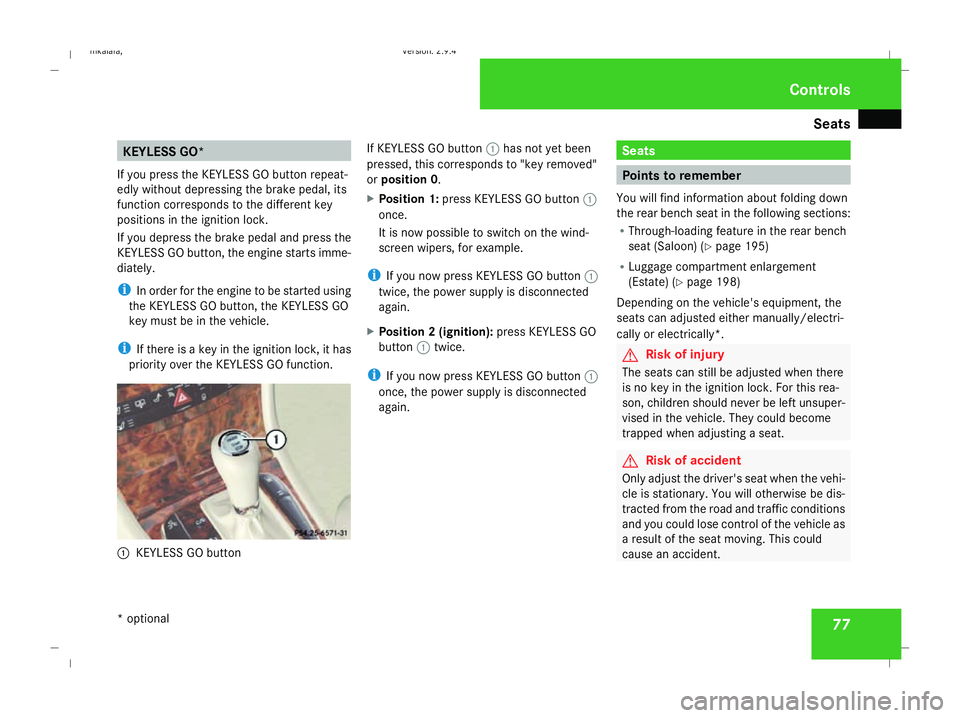
Seats
77KEYLESS GO*
If you press the KEYLESS GO button repeat-
edly without depressing the brake pedal, its
function corresponds to the different key
positions in the ignition lock.
If you depress the brake pedal and press the
KEYLESS GO button, the engine starts imme-
diately.
i In order for the engine to be started using
the KEYLESS GO button, the KEYLESS GO
key must be in the vehicle.
i If there is a key in the ignition lock, it has
priority over the KEYLESS GO function. 1
KEYLESS GO button If KEYLESS GO button
1has not yet been
pressed, this corresponds to "key removed"
or position 0.
X Position 1: press KEYLESS GO button 1
once.
It is now possible to switch on the wind-
screen wipers, for example.
i If you now press KEYLESS GO button 1
twice, the power supply is disconnected
again.
X Position 2 (ignition): press KEYLESS GO
button 1twice.
i If you now press KEYLESS GO button 1
once, the power supply is disconnected
again. Seats
Points to remember
You will find information about folding down
the rear bench seat in the following sections:
R Through-loading feature in the rear bench
seat (Saloon) (Y page 195)
R Luggage compartment enlargement
(Estate) (Y page 198)
Depending on the vehicle's equipment, the
seats can adjusted either manually/electri-
cally or electrically*. G
Risk of injury
The seats can still be adjusted when there
is no key in the ignition lock. For this rea-
son, children should never be left unsuper-
vised in the vehicle. They could become
trapped when adjusting a seat. G
Risk of accident
Only adjust the driver's seat when the vehi-
cle is stationary. You will otherwise be dis-
tracted from the road and traffic conditions
and you could lose control of the vehicle as
a result of the seat moving. This could
cause an accident. Controls
* optional
211_AKB; 2; 5, en-GB
mkalafa, Version: 2.9.4 2008-02-29T16:57:07+01:00 - Seite 77 ZDateiname: 6515_3416_02_buchblock.pdf; preflight
Page 81 of 401
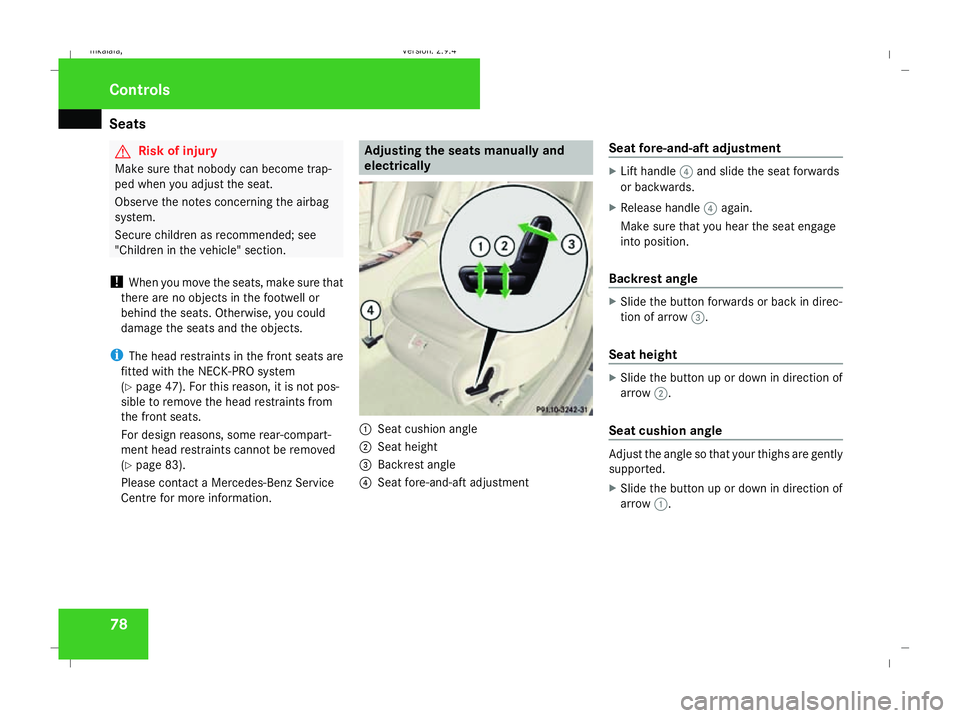
Seats
78 G
Risk of injury
Make sure that nobody can become trap-
ped when you adjust the seat.
Observe the notes concerning the airbag
system.
Secure children as recommended; see
"Children in the vehicle" section.
! When you move the seats, make sure that
there are no objects in the footwell or
behind the seats. Otherwise, you could
damage the seats and the objects.
i The head restraints in the front seats are
fitted with the NECK-PRO system
(Y page 47). For this reason, it is not pos-
sible to remove the head restraints from
the front seats.
For design reasons, some rear-compart-
ment head restraints cannot be removed
(Y page 83).
Please contact a Mercedes-Benz Service
Centre for more information. Adjusting the seats manually and
electrically 1
Seat cushion angle
2 Seat height
3 Backrest angle
4 Seat fore-and-aft adjustment Seat fore-and-aft adjustment X
Lift handle 4and slide the seat forwards
or backwards.
X Release handle 4again.
Make sure that you hear the seat engage
into position.
Backrest angle X
Slide the button forwards or back in direc-
tion of arrow 3.
Seat height X
Slide the button up or down in direction of
arrow 2.
Seat cushion angle Adjust the angle so that your thighs are gently
supported.
X Slide the button up or down in direction of
arrow 1. Controls
211_AKB; 2; 5, en-GB
mkalafa,
Version: 2.9.4 2008-02-29T16:57:07+01:00 - Seite 78Dateiname: 6515_3416_02_buchblock.pdf; preflight
Page 86 of 401
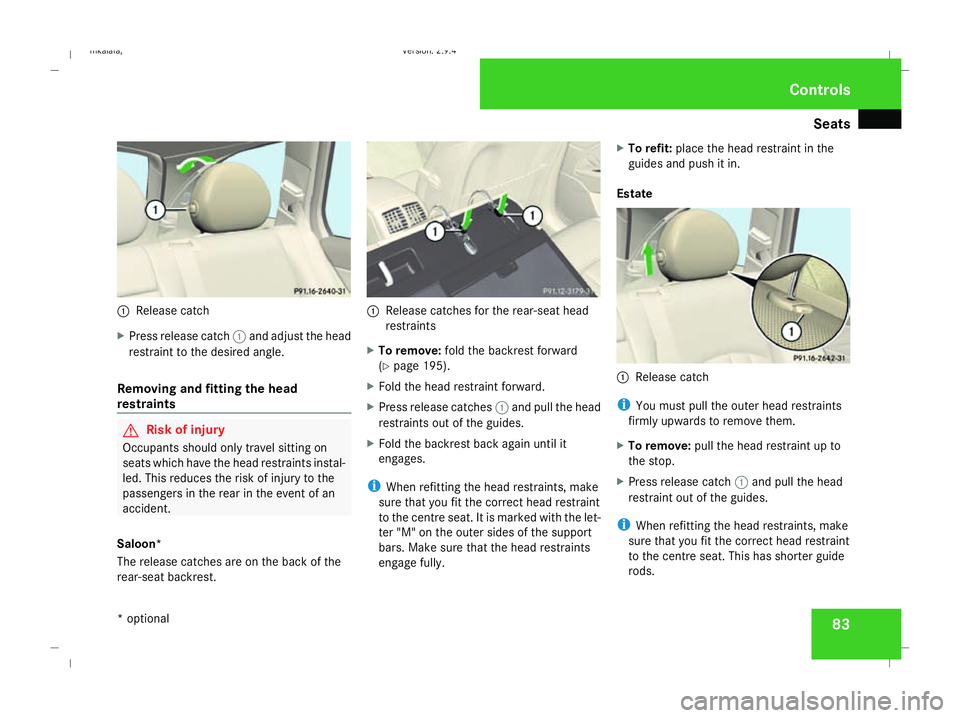
Seats
831
Release catch
X Press release catch 1and adjust the head
restraint to the desired angle.
Removing and fitting the head
restraints G
Risk of injury
Occupants should only travel sitting on
seats which have the head restraints instal-
led. This reduces the risk of injury to the
passengers in the rear in the event of an
accident.
Saloon*
The release catches are on the back of the
rear-seat backrest. 1
Release catches for the rear-seat head
restraints
X To remove: fold the backrest forward
(Y page 195).
X Fold the head restraint forward.
X Press release catches 1and pull the head
restraints out of the guides.
X Fold the backrest back again until it
engages.
i When refitting the head restraints, make
sure that you fit the correct head restraint
to the centre seat. It is marked with the let-
ter "M" on the outer sides of the support
bars. Make sure that the head restraints
engage fully. X
To refit: place the head restraint in the
guides and push it in.
Estate 1
Release catch
i You must pull the outer head restraints
firmly upwards to remove them.
X To remove: pull the head restraint up to
the stop.
X Press release catch 1and pull the head
restraint out of the guides.
i When refitting the head restraints, make
sure that you fit the correct head restraint
to the centre seat. This has shorter guide
rods. Controls
* optional
211_AKB; 2; 5, en-GB
mkalafa,
Version: 2.9.4 2008-02-29T16:57:07+01:00 - Seite 83 ZDateiname: 6515_3416_02_buchblock.pdf; preflight
Page 90 of 401
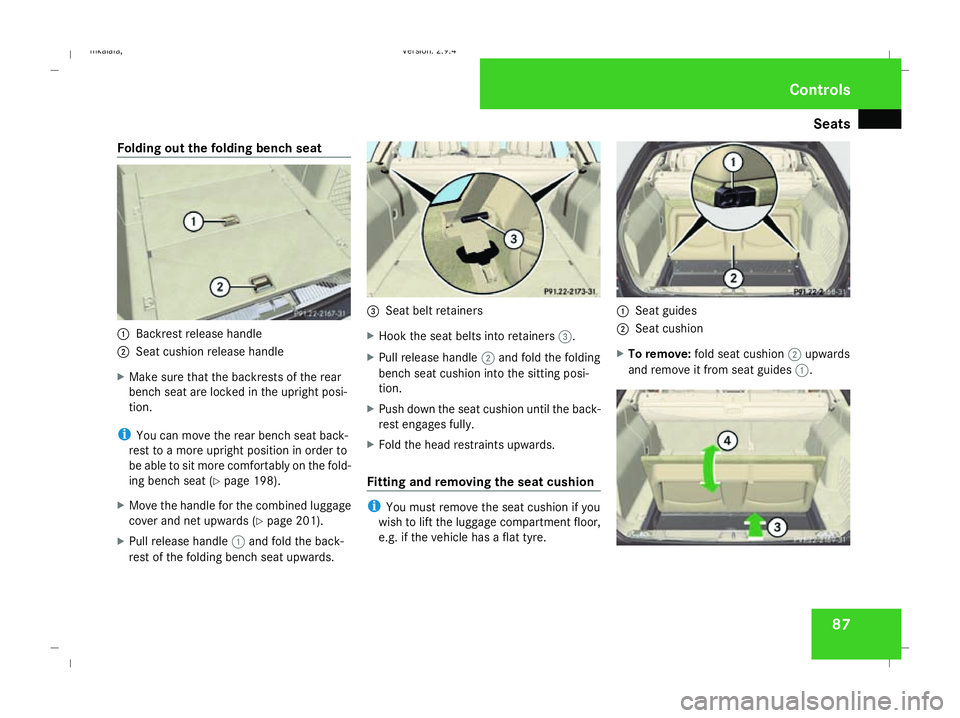
Seats
87
Folding out the folding bench seat
1
Backrest release handle
2 Seat cushion release handle
X Make sure that the backrests of the rear
bench seat are locked in the upright posi-
tion.
i You can move the rear bench seat back-
rest to a more upright position in order to
be able to sit more comfortably on the fold-
ing bench seat (Y page 198).
X Move the handle for the combined luggage
cover and net upwards (Y page 201).
X Pull release handle 1and fold the back-
rest of the folding bench seat upwards. 3
Seat belt retainers
X Hook the seat belts into retainers 3.
X Pull release handle 2and fold the folding
bench seat cushion into the sitting posi-
tion.
X Push down the seat cushion until the back-
rest engages fully.
X Fold the head restraints upwards.
Fitting and removing the seat cushion i
You must remove the seat cushion if you
wish to lift the luggage compartment floor,
e.g. if the vehicle has a flat tyre. 1
Seat guides
2 Seat cushion
X To remove: fold seat cushion 2upwards
and remove it from seat guides 1. Controls
211_AKB; 2; 5, en-GB
mkalafa,
Version: 2.9.4
2008-02-29T16:57:07+01:00 - Seite 87 ZDateiname: 6515_3416_02_buchblock.pdf; preflight
Page 193 of 401
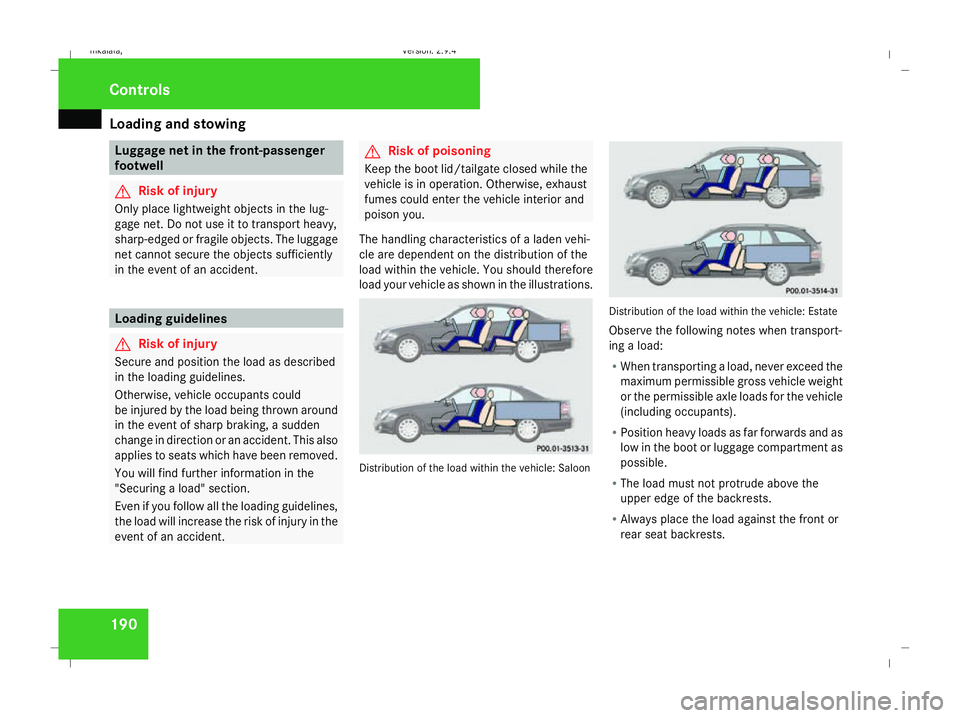
Loading and stowing
190 Luggage net in the front-passenger
footwell
G
Risk of injury
Only place lightweight objects in the lug-
gage net. Do not use it to transport heavy,
sharp-edged or fragile objects. The luggage
net cannot secure the objects sufficiently
in the event of an accident. Loading guidelines
G
Risk of injury
Secure and position the load as described
in the loading guidelines.
Otherwise, vehicle occupants could
be injured by the load being thrown around
in the event of sharp braking, a sudden
change in direction or an accident. This also
applies to seats which have been removed.
You will find further information in the
"Securing a load" section.
Even if you follow all the loading guidelines,
the load will increase the risk of injury in the
event of an accident. G
Risk of poisoning
Keep the boot lid/tailgate closed while the
vehicle is in operation. Otherwise, exhaust
fumes could enter the vehicle interior and
poison you.
The handling characteristics of a laden vehi-
cle are dependent on the distribution of the
load within the vehicle. You should therefore
load your vehicle as shown in the illustrations. Distribution of the load within the vehicle: Saloon Distribution of the load within the vehicle: Estate
Observe the following notes when transport-
ing a load:
R
When transporting a load, never exceed the
maximum permissible gross vehicle weight
or the permissible axle loads for the vehicle
(including occupants).
R Position heavy loads as far forwards and as
low in the boot or luggage compartment as
possible.
R The load must not protrude above the
upper edge of the backrests.
R Always place the load against the front or
rear seat backrests. Controls
211_AKB; 2; 5, en-GB
mkalafa,
Version: 2.9.4 2008-02-29T16:57:07+01:00 - Seite 190Dateiname: 6515_3416_02_buchblock.pdf; preflight
Page 198 of 401
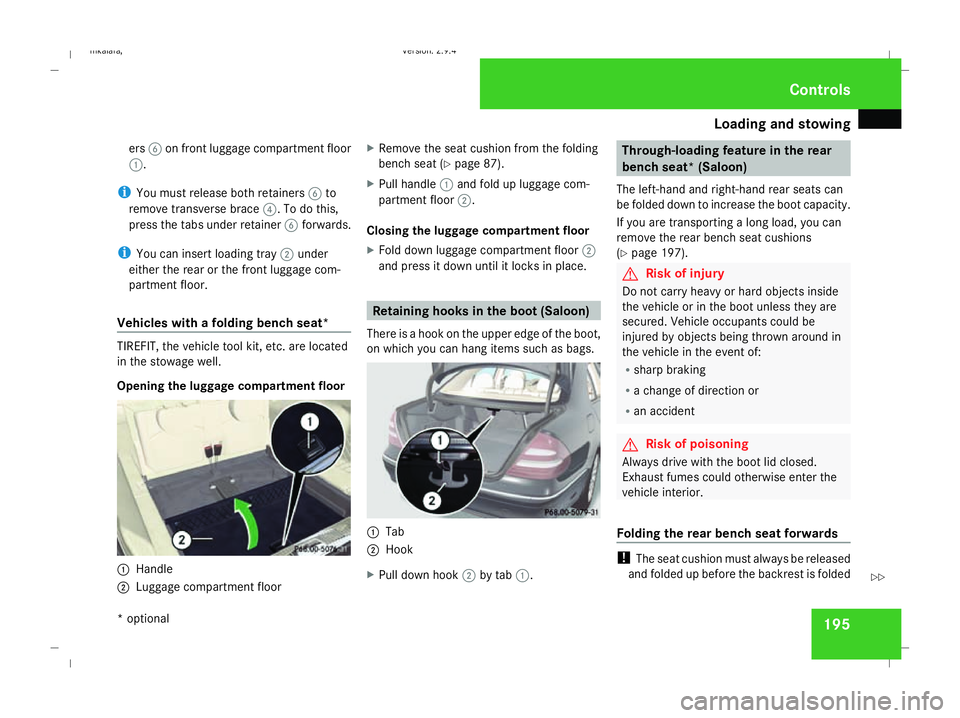
Loading and stowing
195
ers
6on front luggage compartment floor
1.
i You must release both retainers 6to
remove transverse brace 4. To do this,
press the tabs under retainer 6forwards.
i You can insert loading tray 2under
either the rear or the front luggage com-
partment floor.
Vehicles with a folding bench seat* TIREFIT, the vehicle tool kit, etc. are located
in the stowage well.
Opening the luggage compartment floor
1
Handle
2 Luggage compartment floor X
Remove the seat cushion from the folding
bench seat (Y page 87).
X Pull handle 1and fold up luggage com-
partment floor 2.
Closing the luggage compartment floor
X Fold down luggage compartment floor 2
and press it down until it locks in place. Retaining hooks in the boot (Saloon)
There is a hook on the upper edge of the boot,
on which you can hang items such as bags. 1
Tab
2 Hook
X Pull down hook 2by tab 1. Through-loading feature in the rear
bench seat* (Saloon)
The left-hand and right-hand rear seats can
be folded down to increase the boot capacity.
If you are transporting a long load, you can
remove the rear bench seat cushions
(Y page 197). G
Risk of injury
Do not carry heavy or hard objects inside
the vehicle or in the boot unless they are
secured. Vehicle occupants could be
injured by objects being thrown around in
the vehicle in the event of:
R sharp braking
R a change of direction or
R an accident G
Risk of poisoning
Always drive with the boot lid closed.
Exhaust fumes could otherwise enter the
vehicle interior.
Folding the rear bench seat forwards !
The seat cushion must always be released
and folded up before the backrest is folded Controls
* optional
211_AKB; 2; 5, en-GB
mkalafa,
Version: 2.9.4 2008-02-29T16:57:07+01:00 - Seite 195 ZDateiname: 6515_3416_02_buchblock.pdf; preflight
Page 199 of 401
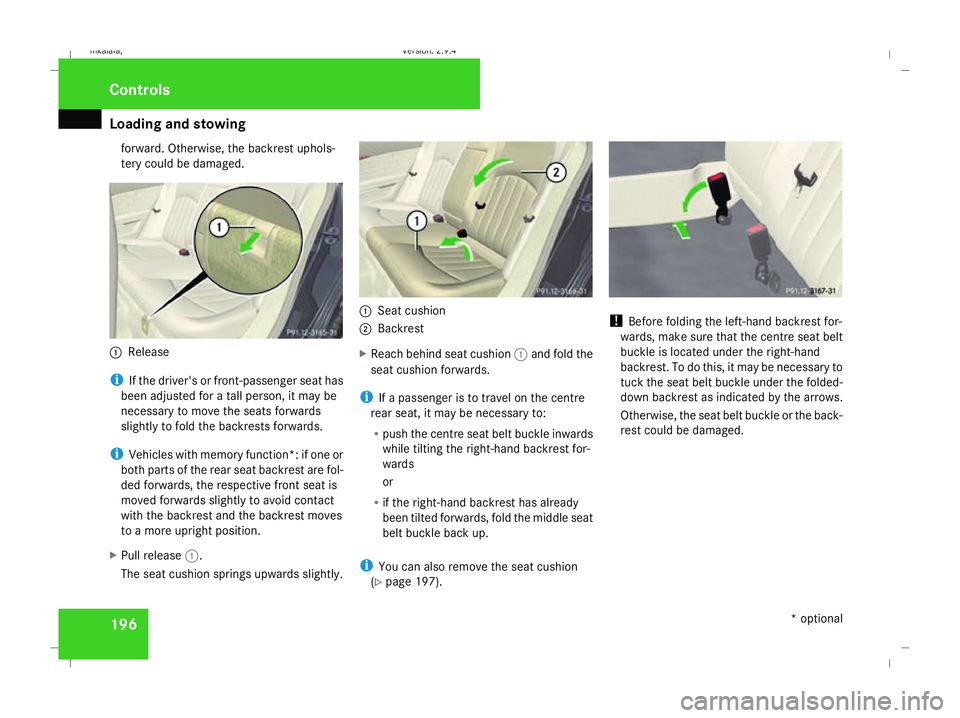
Loading and stowing
196forward. Otherwise, the backrest uphols-
tery could be damaged. 1
Release
i If the driver's or front-passenger seat has
been adjusted for a tall person, it may be
necessary to move the seats forwards
slightly to fold the backrests forwards.
i Vehicles with memory function*: if one or
both parts of the rear seat backrest are fol-
ded forwards, the respective front seat is
moved forwards slightly to avoid contact
with the backrest and the backrest moves
to a more upright position.
X Pull release 1.
The seat cushion springs upwards slightly. 1
Seat cushion
2 Backrest
X Reach behind seat cushion 1and fold the
seat cushion forwards.
i If a passenger is to travel on the centre
rear seat, it may be necessary to:
R push the centre seat belt buckle inwards
while tilting the right-hand backrest for-
wards
or
R if the right-hand backrest has already
been tilted forwards, fold the middle seat
belt buckle back up.
i You can also remove the seat cushion
(Y page 197). !
Before folding the left-hand backrest for-
wards, make sure that the centre seat belt
buckle is located under the right-hand
backrest. To do this, it may be necessary to
tuck the seat belt buckle under the folded-
down backrest as indicated by the arrows.
Otherwise, the seat belt buckle or the back-
rest could be damaged. Controls
* optional
211_AKB; 2; 5, en-GB
mkalafa,
Version: 2.9.4 2008-02-29T16:57:07+01:00 - Seite 196Dateiname: 6515_3416_02_buchblock.pdf; preflight
Page 201 of 401
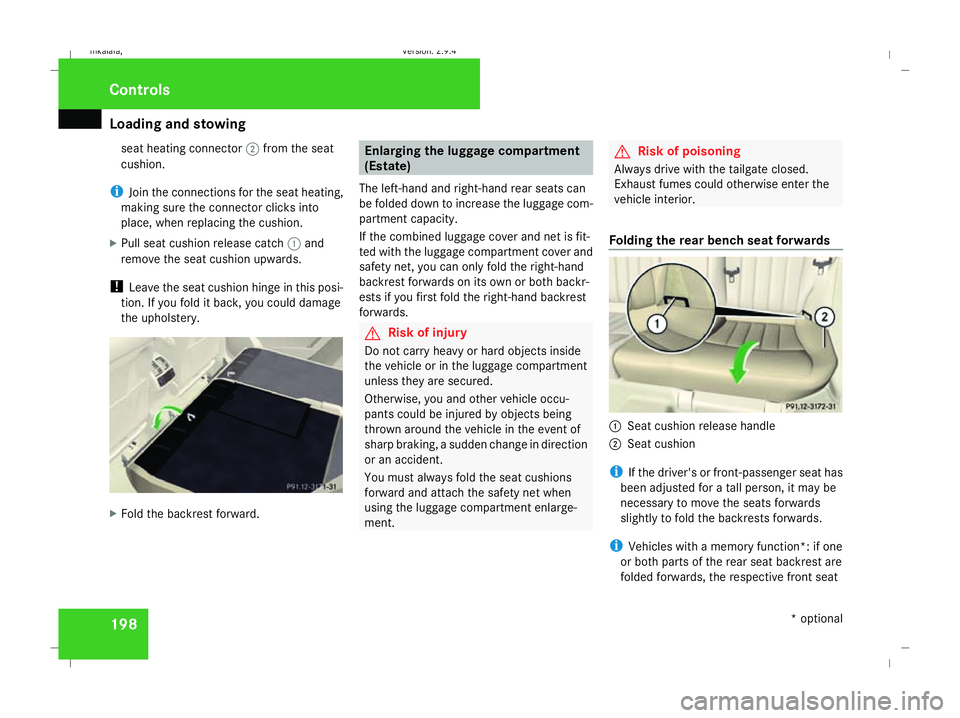
Loading and stowing
198seat heating connector
2from the seat
cushion.
i Join the connections for the seat heating,
making sure the connector clicks into
place, when replacing the cushion.
X Pull seat cushion release catch 1and
remove the seat cushion upwards.
! Leave the seat cushion hinge in this posi-
tion. If you fold it back, you could damage
the upholstery. X
Fold the backrest forward. Enlarging the luggage compartment
(Estate)
The left-hand and right-hand rear seats can
be folded down to increase the luggage com-
partment capacity.
If the combined luggage cover and net is fit-
ted with the luggage compartment cover and
safety net, you can only fold the right-hand
backrest forwards on its own or both backr-
ests if you first fold the right-hand backrest
forwards. G
Risk of injury
Do not carry heavy or hard objects inside
the vehicle or in the luggage compartment
unless they are secured.
Otherwise, you and other vehicle occu-
pants could be injured by objects being
thrown around the vehicle in the event of
sharp braking, a sudden change in direction
or an accident.
You must always fold the seat cushions
forward and attach the safety net when
using the luggage compartment enlarge-
ment. G
Risk of poisoning
Always drive with the tailgate closed.
Exhaust fumes could otherwise enter the
vehicle interior.
Folding the rear bench seat forwards 1
Seat cushion release handle
2 Seat cushion
i If the driver's or front-passenger seat has
been adjusted for a tall person, it may be
necessary to move the seats forwards
slightly to fold the backrests forwards.
i Vehicles with a memory function*: if one
or both parts of the rear seat backrest are
folded forwards, the respective front seat Controls
* optional
211_AKB; 2; 5, en-GB
mkalafa,
Version: 2.9.4 2008-02-29T16:57:07+01:00 - Seite 198Dateiname: 6515_3416_02_buchblock.pdf; preflight